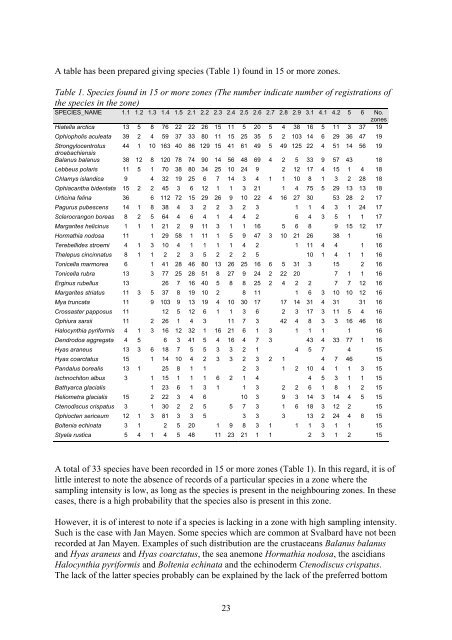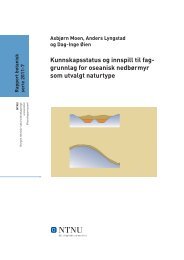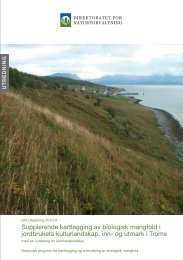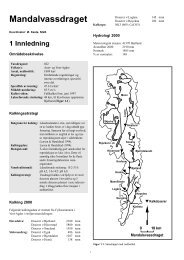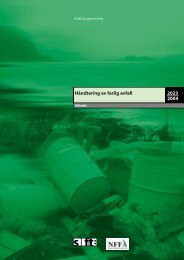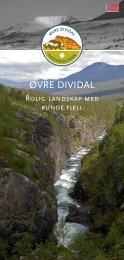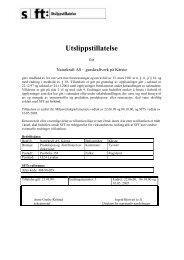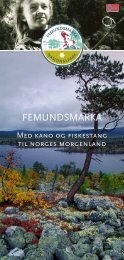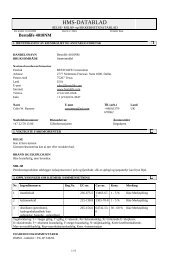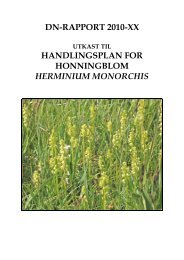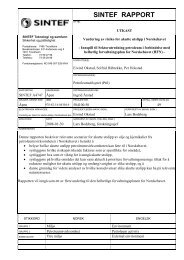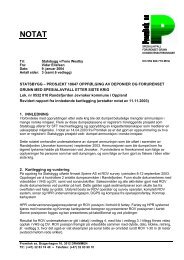Distribution of marine, benthic macro-organisms at Svalbard ...
Distribution of marine, benthic macro-organisms at Svalbard ...
Distribution of marine, benthic macro-organisms at Svalbard ...
You also want an ePaper? Increase the reach of your titles
YUMPU automatically turns print PDFs into web optimized ePapers that Google loves.
A table has been prepared giving species (Table 1) found in 15 or more zones.<br />
Table 1. Species found in 15 or more zones (The number indic<strong>at</strong>e number <strong>of</strong> registr<strong>at</strong>ions <strong>of</strong><br />
the species in the zone)<br />
SPECIES_NAME 1.1 1.2 1.3 1.4 1.5 2.1 2.2 2.3 2.4 2.5 2.6 2.7 2.8 2.9 3.1 4.1 4.2 5 6 No.<br />
zones<br />
Hi<strong>at</strong>ella arctica 13 5 8 76 22 22 26 15 11 5 20 5 4 38 16 5 11 3 37 19<br />
Ophiopholis acule<strong>at</strong>a 39 2 4 59 37 33 80 11 15 25 35 5 2 103 14 6 29 36 47 19<br />
Strongylocentrotus<br />
droebachiensis<br />
44 1 10 163 40 86 129 15 41 61 49 5 49 125 22 4 51 14 56 19<br />
Balanus balanus 38 12 8 120 78 74 90 14 56 48 69 4 2 5 33 9 57 43 18<br />
Lebbeus polaris 11 5 1 70 38 80 34 25 10 24 9 2 12 17 4 15 1 4 18<br />
Chlamys islandica 9 4 32 19 25 6 7 14 3 4 1 1 10 8 1 3 2 28 18<br />
Ophiacantha bident<strong>at</strong>a 15 2 2 45 3 6 12 1 1 3 21 1 4 75 5 29 13 13 18<br />
Urticina felina 36 6 112 72 15 29 26 9 10 22 4 16 27 30 53 28 2 17<br />
Pagurus pubescens 14 1 8 38 4 3 2 2 3 2 3 1 1 4 3 1 24 17<br />
Sclerocrangon boreas 8 2 5 64 4 6 4 1 4 4 2 6 4 3 5 1 1 17<br />
Margarites helicinus 1 1 1 21 2 9 11 3 1 1 16 5 6 8 9 15 12 17<br />
Horm<strong>at</strong>hia nodosa 11 1 29 58 1 11 1 5 9 47 3 10 21 26 38 1 16<br />
Terebellides stroemi 4 1 3 10 4 1 1 1 1 4 2 1 11 4 4 1 16<br />
Thelepus cincinn<strong>at</strong>us 8 1 1 2 2 3 5 2 2 2 5 10 1 4 1 1 16<br />
Tonicella marmorea 6 1 41 28 46 80 13 26 25 16 6 5 31 3 15 2 16<br />
Tonicella rubra 13 3 77 25 28 51 8 27 9 24 2 22 20 7 1 1 16<br />
Erginus rubellus 13 26 7 16 40 5 8 8 25 2 4 2 2 7 7 12 16<br />
Margarites stri<strong>at</strong>us 11 3 5 37 8 19 10 2 8 11 1 6 3 10 10 12 16<br />
Mya trunc<strong>at</strong>a 11 9 103 9 13 19 4 10 30 17 17 14 31 4 31 31 16<br />
Crossaster papposus 11 12 5 12 6 1 1 3 6 2 3 17 3 11 5 4 16<br />
Ophiura sarsii 11 2 26 1 4 3 11 7 3 42 4 8 3 3 16 46 16<br />
Halocynthia pyriformis 4 1 3 16 12 32 1 16 21 6 1 3 1 1 1 1 16<br />
Dendrodoa aggreg<strong>at</strong>a 4 5 6 3 41 5 4 16 4 7 3 43 4 33 77 1 16<br />
Hyas araneus 13 3 6 18 7 5 5 3 3 2 1 4 5 7 4 15<br />
Hyas coarct<strong>at</strong>us 15 1 14 10 4 2 3 3 2 3 2 1 4 7 46 15<br />
Pandalus borealis 13 1 25 8 1 1 2 3 1 2 10 4 1 1 3 15<br />
Ischnochiton albus 3 1 15 1 1 1 6 2 1 4 4 5 3 1 1 15<br />
B<strong>at</strong>hyarca glacialis 1 23 6 1 3 1 1 3 2 2 6 1 8 1 2 15<br />
Heliometra glacialis 15 2 22 3 4 6 10 3 9 3 14 3 14 4 5 15<br />
Ctenodiscus crisp<strong>at</strong>us 3 1 30 2 2 5 5 7 3 1 6 18 3 12 2 15<br />
Ophiocten sericeum 12 1 3 81 3 3 5 3 3 3 13 2 24 4 8 15<br />
Boltenia echin<strong>at</strong>a 3 1 2 5 20 1 9 8 3 1 1 1 3 1 1 15<br />
Styela rustica 5 4 1 4 5 48 11 23 21 1 1 2 3 1 2 15<br />
A total <strong>of</strong> 33 species have been recorded in 15 or more zones (Table 1). In this regard, it is <strong>of</strong><br />
little interest to note the absence <strong>of</strong> records <strong>of</strong> a particular species in a zone where the<br />
sampling intensity is low, as long as the species is present in the neighbouring zones. In these<br />
cases, there is a high probability th<strong>at</strong> the species also is present in this zone.<br />
However, it is <strong>of</strong> interest to note if a species is lacking in a zone with high sampling intensity.<br />
Such is the case with Jan Mayen. Some species which are common <strong>at</strong> <strong>Svalbard</strong> have not been<br />
recorded <strong>at</strong> Jan Mayen. Examples <strong>of</strong> such distribution are the crustaceans Balanus balanus<br />
and Hyas araneus and Hyas coarct<strong>at</strong>us, the sea anemone Horm<strong>at</strong>hia nodosa, the ascidians<br />
Halocynthia pyriformis and Boltenia echin<strong>at</strong>a and the echinoderm Ctenodiscus crisp<strong>at</strong>us.<br />
The lack <strong>of</strong> the l<strong>at</strong>ter species probably can be explained by the lack <strong>of</strong> the preferred bottom<br />
23


